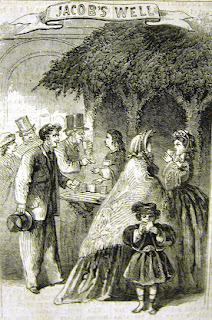The funds raised at the 1864 Metropolitan Fair supported the United States Sanitary Commission, an enormous civilian affiliate of the Union Army. The Sanitary Commission assumed many duties during the War.
Here men and women in Augusta (Georgia?)
hand out doughnuts to Union soldiers.
They acted somewhat like the USO in 20th century wars, giving soldiers beverages and refreshments.
This Philadelphia "saloon" adjacent to a soldier's hospital announced it's presence with a magnificent eagle sculpture. Volunteers gave soldiers a place to rest, socialize and drink non-alcoholic beverages.
Another volunteer saloon adjacent to a hospital.
The Sanitary Commission ran the hospitals too. Following Florence Nightingale's leadership in England's Crimean War, this civilian organization saw a need and filled it.
They managed large hospitals in cities like Washington
And field hospitals such as this one in Gettysburg.
Activities went beyond physical nursing.
They had systems for troop mail.
Drawing by Alfred Waud
showing the Sanitary Commission tossing tobacco to freed prisoners.
The USCC also ran lodges---rehabilitation homes for convalescent soldiers.
Above a Lodge for Invalid Soldiers in Alexandria, Virginia.
And a Lodge in Washington.
The activities of the Sanitary Commission were well documented. The leaders realized that good public relations increased donations. In many of the photographs we see women, as in this photo of a field station in Fredericksburg.
Women were not at the very top of the organization but they were, as we might say, middle management throughout the country. In many of the photographs we also see crates and barrels full of materials headed for the hospitals and recovery lodges.
One of the major functions was coordinating donations for the hospitals, lodges, saloons and doughnut stops.
Women knitted socks, pieced quilts, stitched underwear and nightcaps for recovering soldiers.
Barrels and boxes from the Christian Commission.
Wagons full of supplies heading for the front.
They have scanned many Civil War photos at a high resolution so you can open the TIFF files and examine the smallest details.
Click on this one and open the smaller TIFF file.
http://www.loc.gov/pictures/item/cwp2003000469/PP/
You can see so much in their faces. I am always interested in how each working woman found a solution to the hoop skirt dilemma. There is quite a range of circumference.
































































